Last month, we provided some safety information for when you go boating. One safety tip was a pre-launch boat check. Here are items that you should have on board.
Items to Check
- Your fuel tank should be full. If that is not possible, you should have enough fuel to return safely and still have some left over.
- Check the engine oil and coolant levels.
- Make sure your navigational lights work.
- Make sure your instrument panel lights work.
- Check ventilation in any powered vessel, auxiliary-powered sailboats or boats using cooking fuel such as LPG (propane).
- Check that enclosed areas have a properly-installed and working carbon monoxide detector.
- Check that bilges are dry and pumps not running excessively. (Spilled oil or waste in bilges should be cleaned up.)
- Check the weather forecast.
- Check your dock lines for chafe or wear.
- Leave a “float plan” with at least one person on land so they know where you can be found.
Items that Should be On Board
Here is the “short list.” Explanations are further down.
- Basic toolbox with tools appropriate for your boat.
- Spare parts including fuel filter, light bulbs, head parts, through-hull plugs, etc.
- Standard first-aid kit
- Life jackets
- Horn or other sound producing device
- All lights (including flashlight and spare batteries) and needed day-shapes
- Distress Signals
- Have all required fire extinguishers on board and that they are mounted properly.
- Have a radio on board to receive weather updates.
- All needed battery types (and check that they are working)
- At least one anchor set up and bent-on to your anchor line.
- 2-3 extra dock lines in case of unusual conditions.
- At least two fenders on-board for docking or towing if required.
- Ship’s papers, radio license, fishing permit, etc. on board.
- Chart(s) for the area(s) you will be in regardless of the level of your local knowledge.
- Both an Emergency Position Indicating Radio Beacon (EPIRB) for your boat and a Personal Locator Beacon (PLB) for you. Both beacons should be registered (EPIRB to your boat and PLB to you) at www.beaconregistration.noaa.gov
More Information About Items Above
Life Jackets
- 1 life jacket per passenger (minimum 2 at all times). Life jackets should be Coast Guard approved.
- If your vessel is over 16 feet long, you should have a throwable device.
- Tell all passengers and crew new to the vessel the location of the life jackets and how to use them.
Sound Producing Devices
- The horn you have on board should be able to sound a four-second blast that can be heard for at least a ½ mile.
- Make sure to have a spare can of air (or alternate device) if you use a portable air horn.
- Each life jacket should have a whistle attached.
Day-Shapes
“Day shapes are mast head signals visually indicating the status of a vessel to other vessels on navigable waters during daylight hours whether making-way, anchored, or aground.” (Wikipedia) If you plan to engage in recreational boating activity that requires a day-shape, make sure that you have it.
Distress Signals
Your flares, day signals and other items used for signaling should be stored in a dry location that is easily accessible. Be sure the crew and passengers know where they are and how to use them properly.
Fire Extinguishers
- Coast Guard rules set the number of fire extinguishers you should have on board. Make sure you have the number required and that they are accessible.
- Check to be sure mounts are secure and functional before departure.
- Inform passengers and crew of the fire extinguisher(s) location.
Ventilation
- All interior spaces should be checked. They should be well-ventilated before departure.
- If you smell fuel, run the blowers for several minutes and check again.
- If you still smell the odor, turn off the engine and check for the source of the leak.
- Each enclosed or semi-enclosed area should have a properly-installed carbon monoxide detector.
Batteries
- For dual charging systems, make sure the selector switch in the proper position.
- Make sure the entire vessel has power.
- Have spares for all your devices on board (handheld radio, flashlight, portable navigational aid, etc.)
- Make sure rechargeable batteries are charged.
Content provided by boatsafe.com





